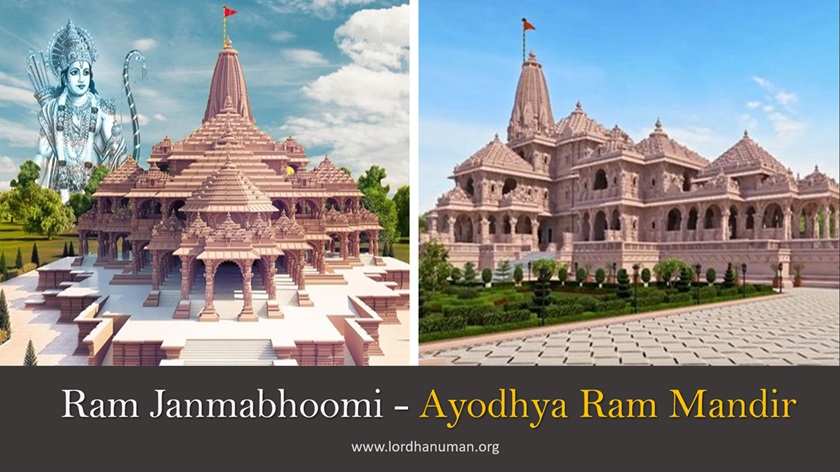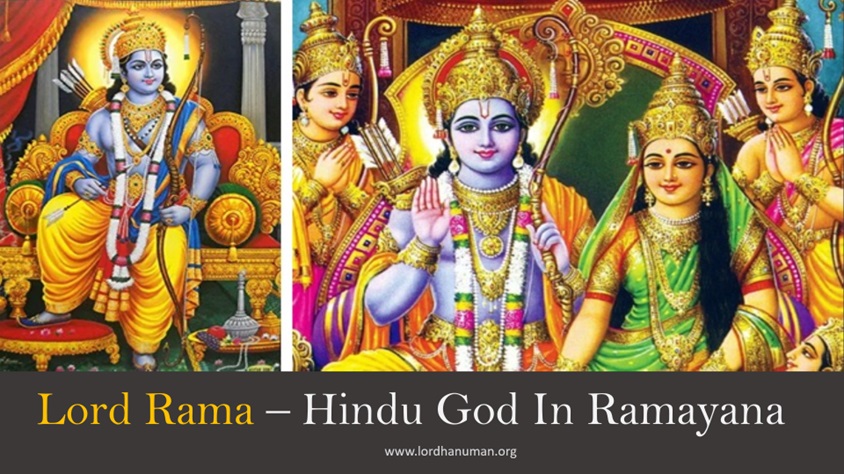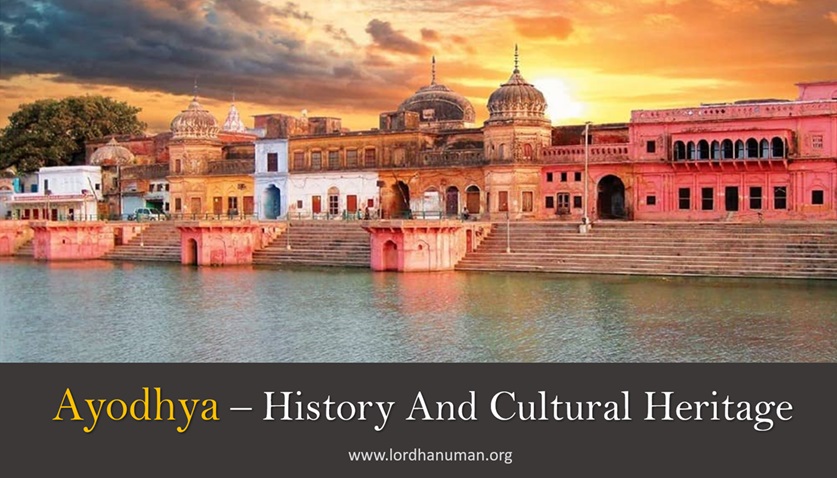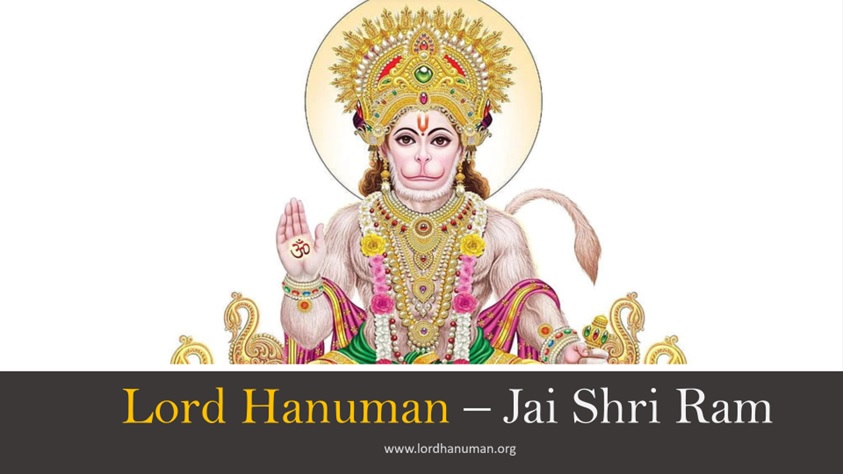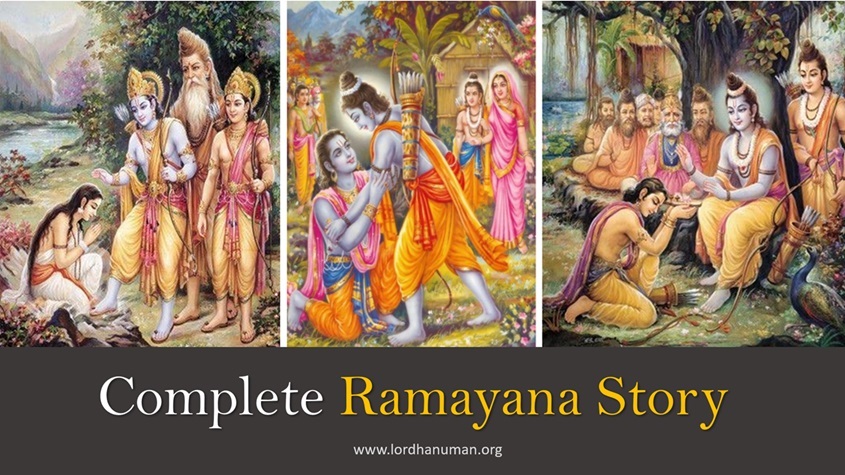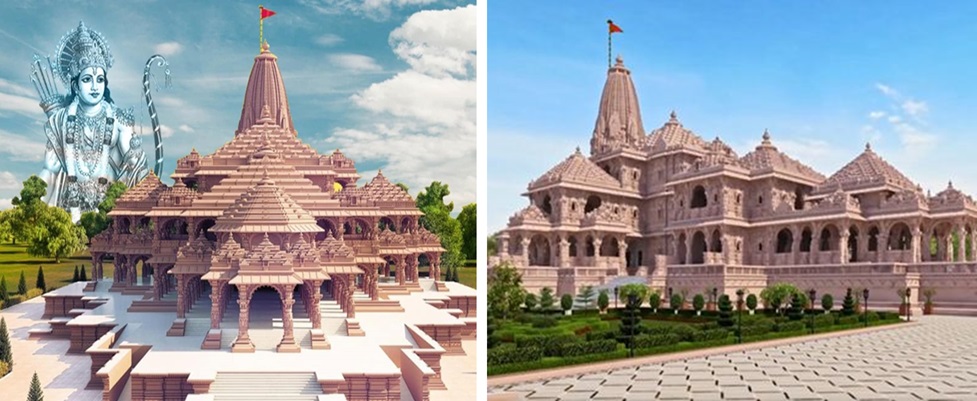
Ayodhya Ram Mandir
अयोध्या राम मंदिर
Dedicated to Lord Rama, the Ram Temple is located in the ancient sacred holy city of Ayodhya, the birthplace of Rama in Uttar Pradesh, India.
The Ayodhya Ram Mandir stands as a testament to the intricate interweaving of faith, history, and devotion for Lord Rama in the heart of India. Nestled in the ancient city of Ayodhya along the banks of the sacred Sarayu River, the temple dedicated to Lord Ram has been a focal point of religious and socio-political discourse for centuries.
The Ayodhya Ram Mandir holds immense significance for Hindus and followers of Sanatana Dharma due to its association with Lord Rama, a revered figure in Hinduism. The importance of the Ayodhya Ram Mandir can be understood from various perspectives.
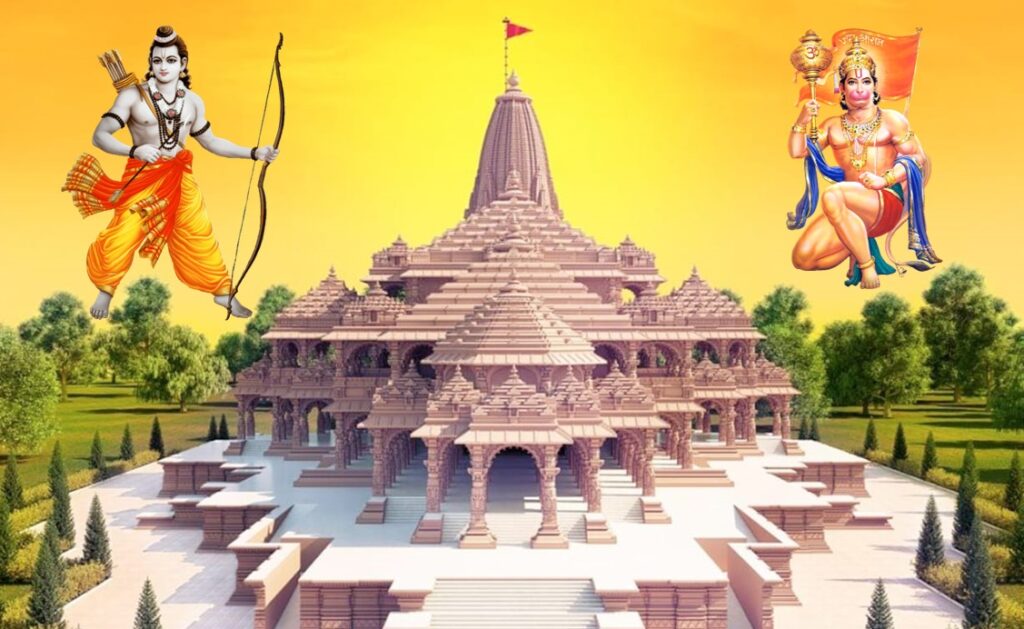
Ayodhya Ram Temple consecration ceremony was successfully completed in Ayodhya as per the muhurta schedule. Prime Minister Narendra Modi performed the ‘Pran Pratishtha’ Puja in front of a 51-inch idol of Lord Ram, sculpted by Arun Yogiraj.
During the puja ceremony, PM Modi was accompanied by UP chief minister Shri Yogi Adityanath and RSS chief Shri Mohan Bhagwat. This event was also attended by a group of special invitees, which included top Hindu religious leaders, industrialists, Bollywood personalities, politicians, and foreign dignitaries from over 130 countries.
PM Modi performed the puja for the ‘Pran Pratistha’ on January 22 at 12.20 pm Muhurta time. In view of the VIP security, access to the main Ram temple was not open to the public. However, people can visit Ayodhya Ram Mandir after the consecration ceremony is over on January 23rd.
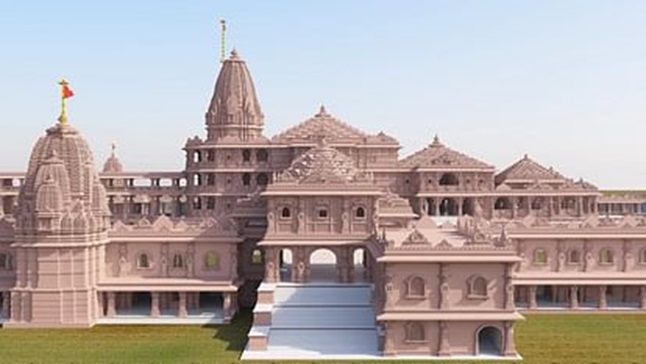
The groundbreaking ceremony for the beginning of the construction of the Ram temple was done on 5 August 2020. The temple currently under construction is being overseen by the Shri Ram Janmabhoomi Teerth Kshetra Trust. The inauguration of the temple is scheduled for 22 January 2024.
Ram Mandir History
In the 16th century, Mughal invader from Afghanistan Babur attacked and destroyed the temple in his series of invasions throughout northern India. The existing Ram Temple was completely destroyed in this Mughal invasion.
Later, the Mughals built a mosque, the Babri Masjid, which is believed to be the site of Rama’s birthplace, Ram Janmabhoomi. The earliest record of a mosque is found in 1767 in the Latin book Discriptio India written by Jesuit missionary Joseph Tiefenthaler.
According to him, the mosque was built by demolishing the Ramkot temple, which is believed to be Ram’s fort in Ayodhya, and Bedi, which is the birth place of Lord Rama.
The first incident of religious violence was recorded in 1853 during the British rule over India and prior to India’s independence. In December 1858, the British administration banned Hindus from conducting pujas (rituals) at the disputed site. A stage was erected outside the mosque to conduct rituals.
अयोध्या राम मंदिर
Archaeological Excavations Survey
Two archaeological excavations were carried out by the Archaeological Survey of India (ASI) in 1978 and 2003. As reported by the Ram Janmabhoomi Trust, both these surveys have found conclusive evidence of remains of a ancient Hindu temple existed at the site. The survey also helped Hindus to establish their claim and present this crucial piece evidence to the Indian courts.
Image Credit – Ram Janmbhoomi Trust
Remains Of Ancient Temple
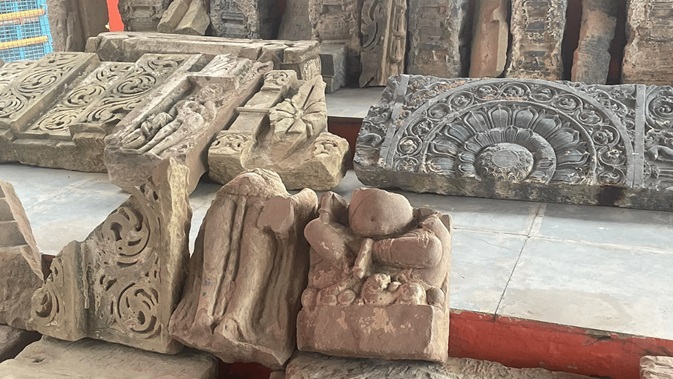
Remains Of Ancient Temple
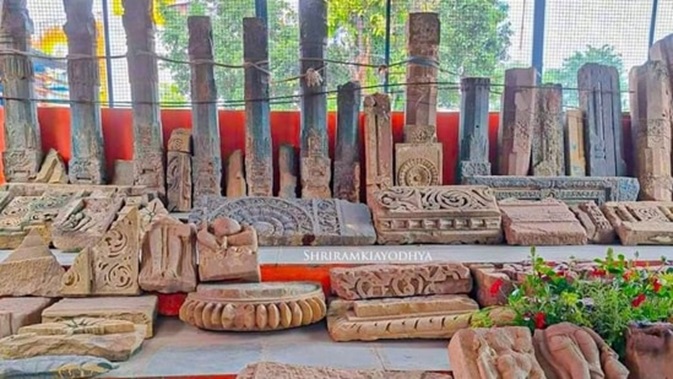
Ram Janmabhoomi Movement
The Ram Janmabhoomi Movement, a socio-political and religious movement in India, revolved around the Ayodhya dispute and the claim that the Babri Masjid in Ayodhya was constructed on the birthplace of Lord Rama. The movement gained momentum in the late 20th century, leading to significant political and social consequences.
The Ayodhya dispute dates back to the 16th century when the Babri Masjid was allegedly built by the Mughal Emperor Babur on the site believed to be the birthplace of Lord Rama. The dispute became more prominent in the 19th and 20th centuries as various Hindu and Muslim groups contested ownership.
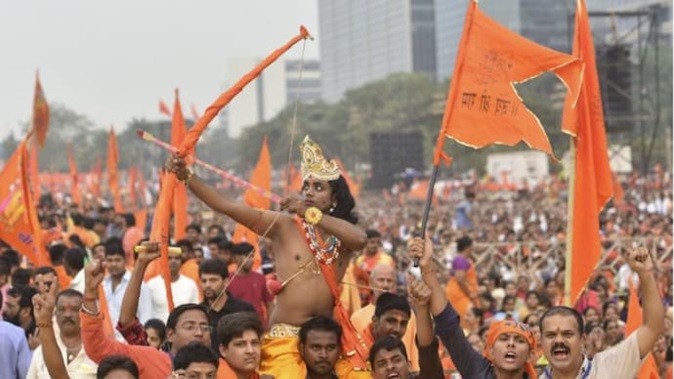
Ram Janmabhoomi Movement Timeline
- 1984: The Vishwa Hindu Parishad (VHP) launches the movement, seeking the construction of a temple dedicated to Lord Rama at the disputed site.
- 1986: The locks on the Babri Masjid are opened, allowing Hindu worshippers to enter. The movement intensifies with calls for the construction of a Rama temple.
- 1992: On December 6, the Babri Masjid is demolished by a large mob of Hindu activists, leading to widespread communal tensions.
Ram Janmabhoomi Movement Ratha Yatra
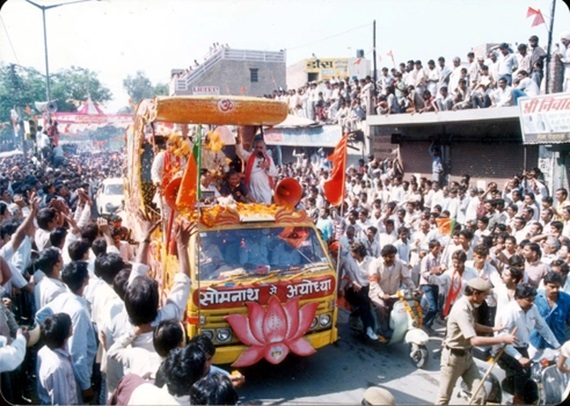
The Ram Janmabhoomi Movement Ratha Yatra was a significant event during the 1990s, organized by the Vishwa Hindu Parishad (VHP) and other associated groups. The procession involved a chariot carrying an idol of Lord Rama, traversing various cities to mobilize support for the construction of the Ram Temple in Ayodhya.
The Ratha Yatra aimed to galvanize public sentiment and gather momentum for the cause, culminating in the eventual demolition of the Babri Masjid in 1992. The yatra played a pivotal role in shaping the narrative of the movement, elevating the Ayodhya dispute to the forefront of Indian politics.
अयोध्या राम मंदिर
Proposed Inauguration Of Ram Temple
The Ram Mandir is under construction and scheduled to be inaugurated by Indian Prime Minister Shri Narendra Modi on January 22, 2024. The preparations for this mega event are in full swing ahead of the ‘Pran Pratishtha’ (consecration ceremony). Delegates from many countries will also attend this grand function.
The ‘Pran-Pratishtha‘ or consecration ceremony of Ram Lalla’s idol will take place at the temple on January 22, 2024. To mark the occasion, Ayodhya will celebrate Amrit Mahotsav from January 14 to January 22.
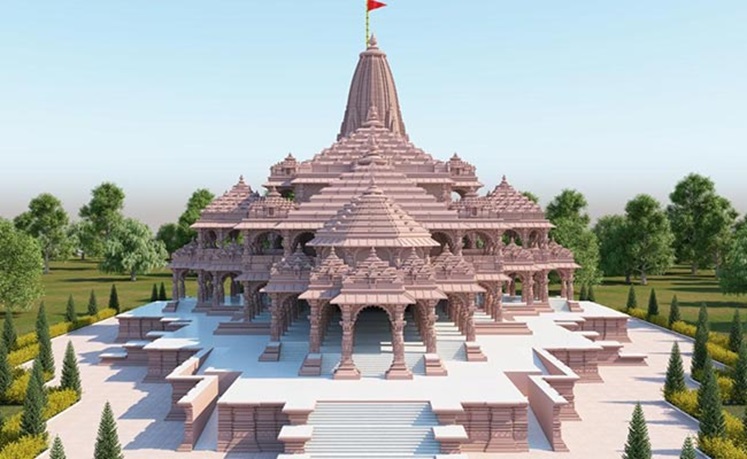
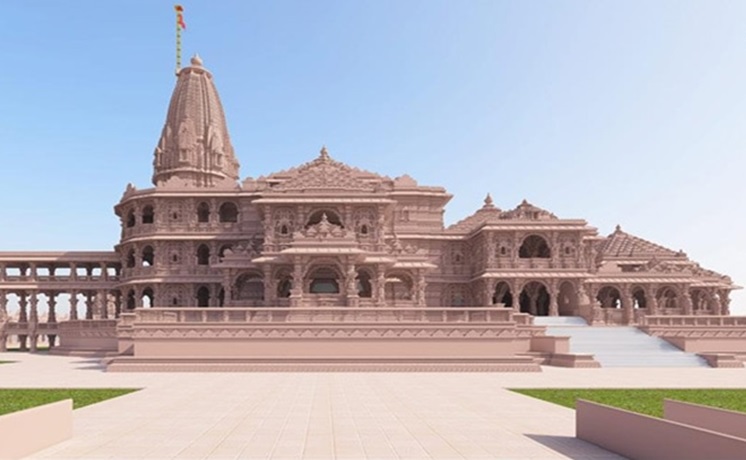
As part of it, 1008 Hundi Mahayagya will be organised, and special Lungars (meals) have also been arranged to feed the thousands of devotees scheduled to attend the ceremony.
The construction of Ram Mandir is being managed and organized by the Shri Ram Janmbhoomi Teerth Kshetra Trust. The architecture of the proposed Ram temple was designed in year 1988 by the Ahmedabad based Sompura family .
The Sompuras have contributed to the design of over 100 temples worldwide for at least 15 generations, including the Somnath temple. The chief architect of the temple was Chandrakant Sompura, and he was assisted by his two sons Nikhil Sompura and Ashish Sompura, who are also architects.
Proposed Construction Of Ram Temple
The main structure of the temple will be built on a raised platform and will have three storeys. It will have five mandapas in the middle of the garbhagriha (sanctum sanctorum) and on the entryway. Three mandapas on one side shall be of Kudu, Nritya, and Rang, and the two mandapas on the other side will be of Kirtan and Prarthana. In Nagara style, the mandapas are to be decorated with shikhara.
The building will have a total of 366 columns. The columns will have 16 idols each to include the incarnations of Shiva, the 10 Dashavataras, the 64 Chausath Yoginis, and the 12 incarnations of the goddess Saraswati. The width of the stairs will be 16 feet (4.9 m). In accordance with scriptures dedicated to the design of temples dedicated to Vishnu, the sanctum sanctorum will be octagonal.
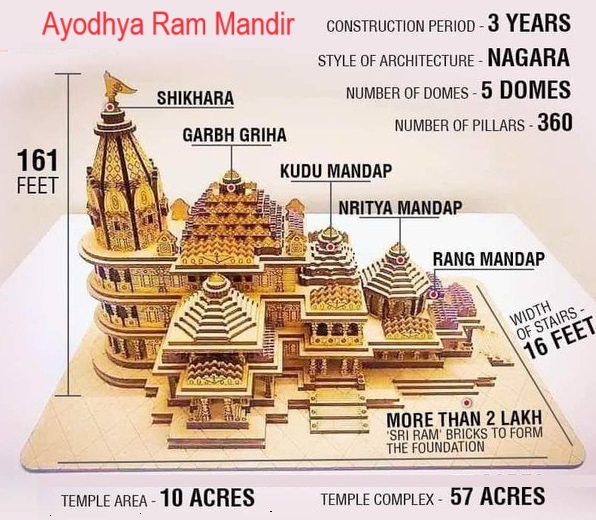
The temple will be built in 10 acres (0.040 km2), and 57 acres (0.23 km2) of land will be developed into a complex with a prayer hall, a lecture hall, an educational facility and other facilities including a museum and a cafeteria.
The construction work will be accomplished with 600 thousand cubic feet of sandstone from Bansi pahadpur village mountain in Rajasthan. There will be no use of iron in the construction of the temple, and the fusing of the stone blocks will require ten thousand copper plates.
In a culturally significant move, Thailand is symbolically contributing to the inauguration of the Ram Temple in Ayodhya by sending soil to the Ram Janmabhoomi, building on their prior gesture of sending water from two rivers in Thailand to honor the temple.
Construction Of The Ram Mandir
Following the Supreme Court’s verdict, the construction of the Ram Mandir gained momentum. The Shri Ram Janmabhoomi Teerth Kshetra, a trust established to oversee the construction, played a pivotal role. The design for the temple, which draws inspiration from traditional Indian architecture, was unveiled, and the foundation-laying ceremony took place on August 5, 2020, with the Prime Minister of India, Narendra Modi, participating in the event.
The construction of the Ram Mandir involves intricate craftsmanship and meticulous planning. Skilled artisans and craftsmen from various parts of India are contributing their expertise to create a magnificent temple that symbolizes the grandeur of Lord Rama’s kingdom.
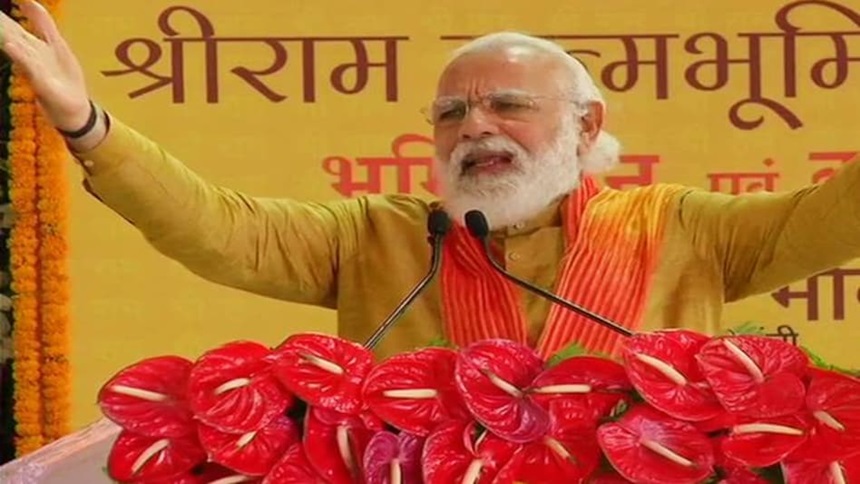
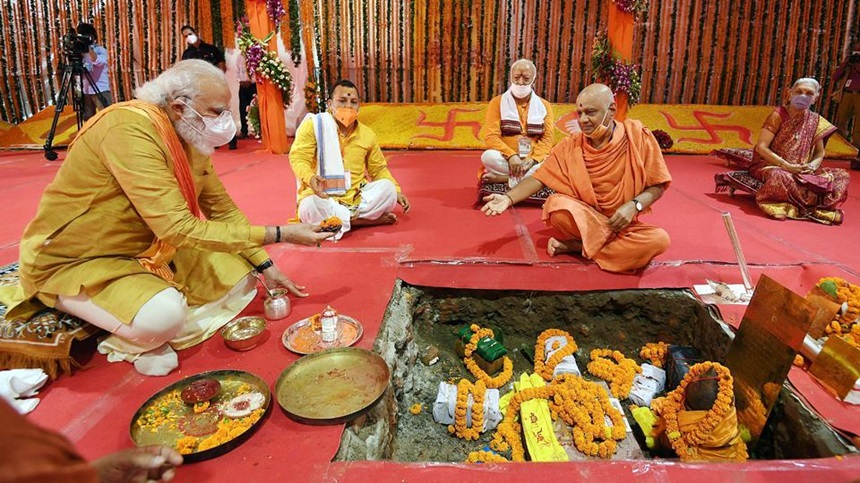
The proposed Ayodhya Ram Mandir completion date is set for January 22, 2024, in line with the construction company’s projected timeline. The renowned construction company Larsen & Toubro is responsible for building this monumental temple, with an estimated cost of Rs 18,000 crore. The temple construction project is completely funded by the large number of devotees spread across the world.
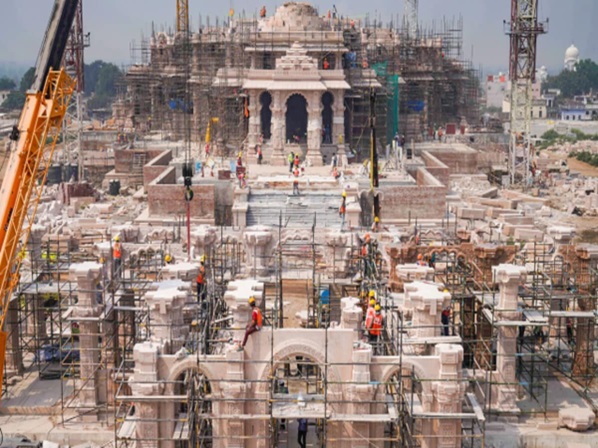
Ram Mandir Ayodhya Location
Lord Rama
Lord Rama is considered the seventh incarnation (avatar) of Lord Vishnu. Lord Vishnu, one of the principal deities in Hinduism, incarnated on Earth to uphold righteousness (dharma) and establish moral and ethical values. The life and teachings of Lord Rama are chronicled in the epic Hindu scripture, the “Ramayana,” which is attributed to the sage Valmiki.
The history of Lord Rama is primarily chronicled in the epic Hindu scripture known as the “Ramayana.” Lord Rama, also referred to as Shri Ram, is considered the seventh avatar (incarnation) of Lord Vishnu, one of the principal deities in Hinduism.
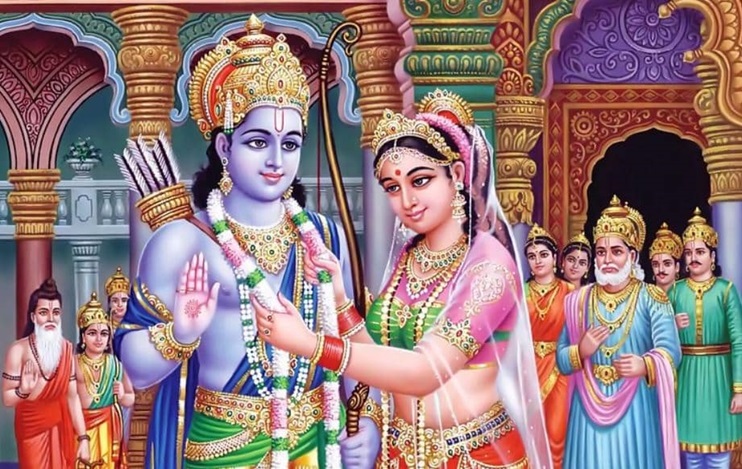
The story of Rama is a significant part of Hindu mythology and has been passed down through generations as a tale of virtue, righteousness, and devotion.
Ayodhya Ram Mandir
Features of Shri Ram Janmabhoomi Temple Under Construction in Ayodhya
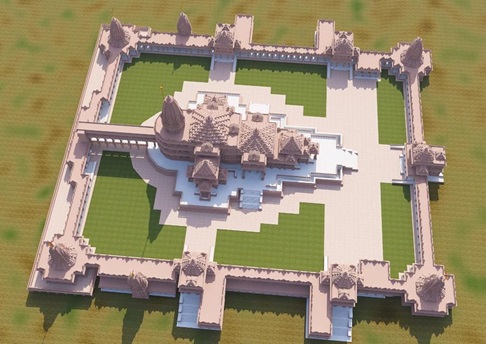
- The Ram Temple is being built in traditional Nagar style architecture.
- The length of the temple (from east to west) will be 380 feet, width will be 250 feet and height will be 161 feet.
- The temple will be three storeyed. The height of each floor will be 20 feet. There will be a total of 392 pillars and 44 gates in the temple.
- There will be a child form of Lord Shri Ram (deity of Shri Ram Lalla Sarkar) in the main sanctum and Shri Ram Darbar on the first floor.
- There will be 5 pavilions in the temple: Dance Pavilion, Color Pavilion, Sabha Pavilion, Prayer Pavilion and Kirtan Pavilion. 6. Statues of Gods and Goddesses are being carved on the pillars and walls.
- Entry to the temple will be from the east side, by climbing 32 stairs and from Singhdwar.
- There will be provision of ramp and lift in the temple to facilitate the movement of the disabled and elderly people.
- The temple premises will be provided with a rectangular wall all around the temple boundry. Its total length in all four directions will be 732 meters and height will be 14 feet.
- Four temples dedicated to Sun God, Mother Bhagwati, Ganapati and Lord Shiva will be built at the four corners of the park. There will be a temple of Maa Annapurna in the northern arm, and a temple of Hanuman ji in the southern arm.
- Sitakoop of mythological period will be present near the temple.
- Other temples proposed in the temple complex will be dedicated to Maharishi Valmiki, Maharishi Vashishtha, Maharishi Vishwamitra, Maharishi Agastya, Nishadraj, Mata Shabari and Rishipatni Devi Ahilya.
- The ancient temple of Lord Shiva has been renovated on Navratna Kuber Tila in the south-western part and Jatayu statue has been installed there.
- The temple is being built with stones from Rajasthan. Similarly, Iron and concrete has not been used in the temple construction.
- 14 meter thick Roller Compacted Concrete (RCC) has been laid under the temple. It has been given the form of an artificial rock.
Ayodhya Ram Mandir
Ram Rajya
Ram Temple Represents Ram Rajya
“Ram Rajya” is a term that holds significant cultural and religious importance in Hinduism, particularly in the context of the epic Ramayana. It refers to an ideal state or kingdom based on the principles of righteousness, justice, and virtuous governance. The term is derived from the character of Lord Rama, the seventh avatar of Lord Vishnu, as depicted in the Ramayana.
In the Ramayana, Lord Rama is revered for his unwavering commitment to dharma (righteousness) and his exemplary qualities as a king. “Ram Rajya” symbolizes the utopian rule of Lord Rama during his reign in the city of Ayodhya. The characteristics of “Ram Rajya” include Dharma , Justice , Rule Of Law , Fairness , Peace , Harmony, equality , Good Governance and spiritual value system.

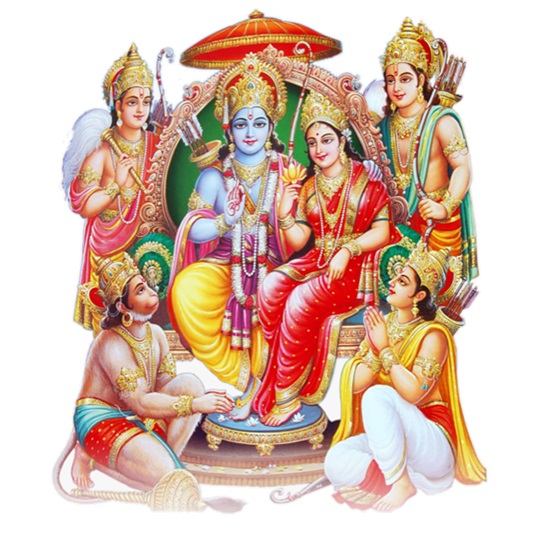
The Ayodhya Ram Mandir holds immense significance in Hinduism and is intricately connected to the epic Ramayana. The temple stands at the revered birthplace of Lord Rama, the seventh avatar of Lord Vishnu.
According to the Ramayana, Ayodhya was ruled by King Dasharatha, and Lord Rama was born to him and Queen Kaushalya. The epic Ramayana Story narrates Rama’s exile, the abduction of his wife Sita by the demon king Ravana, and the subsequent war leading to Ravana’s defeat and Sita’s rescue.
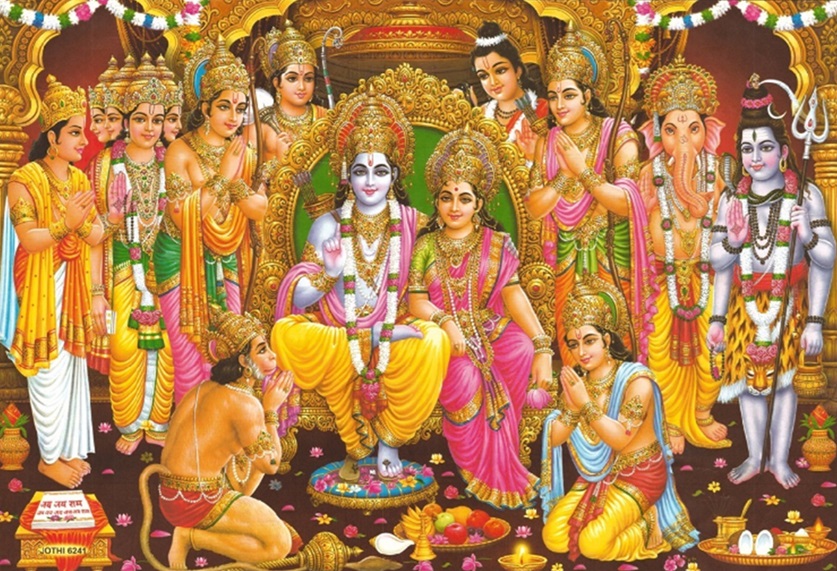
After the triumphant return to Ayodhya, Lord Rama’s reign as a just and righteous king became a celebrated era known as “Ram Rajya.” The construction of the Ayodhya Ram Mandir represents the realization of a long-standing aspiration for Hindus and the recognition of Ayodhya as a sacred pilgrimage site.
It serves as a symbol of cultural and religious heritage, encapsulating the teachings and values embodied in the Ramayana, and stands as a testament to the enduring devotion and reverence for Lord Rama in Sanatana Dharma.
Ayodhya
Historical Significance of Ayodhya
Ayodhya, one of the oldest continuously inhabited cities in the world, is revered in Hinduism as the birthplace of Lord Ram, the seventh avatar of Lord Vishnu. According to the epic Ramayana, Ayodhya was ruled by the illustrious King Dasharatha, whose son Ram is considered a symbol of virtue, righteousness, and the embodiment of dharma (moral and social duties).
The city has been a pilgrimage site for millions of devotees who seek to connect with the divine essence of Lord Ram and the ancient heritage of Ayodhya.
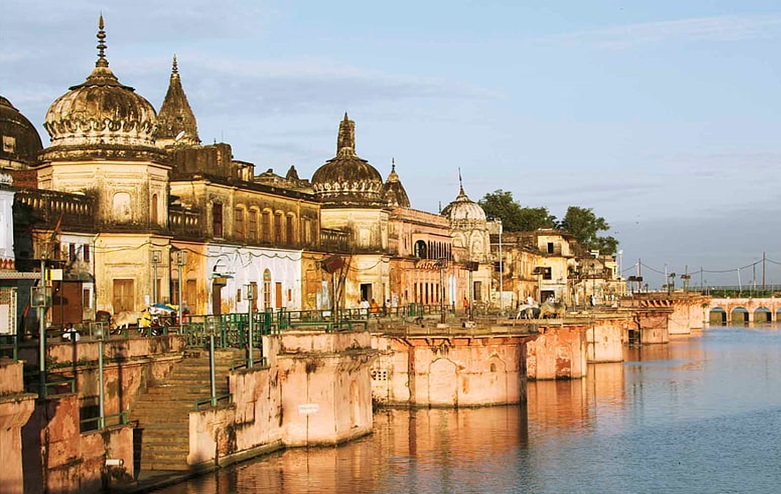
Ayodhya, situated on the banks of the Sarayu River in the northern state of Uttar Pradesh, India, is one of the seven holiest cities in Hinduism. Revered as the birthplace of Lord Rama, the seventh avatar of Lord Vishnu, Ayodhya is mentioned in ancient scriptures like the Ramayana. The city is not merely a physical location but a symbol of righteousness, dharma, and the ideals of an ideal kingdom.
Rama Returns To Ayodhya
Ayodhya Ram Mandir Historical Significance
The Ayodhya Ram Mandir represents not only the physical construction of a grand temple but also the culmination of a complex and contentious historical narrative. It symbolizes the resilience of faith, the pursuit of justice through legal means, and the potential for reconciliation and communal harmony.
As the temple takes shape on the banks of the Sarayu River, it stands as a testament to the multifaceted nature of India’s cultural and religious landscape, inviting contemplation on the past, present, and future. The story of Ayodhya and the Ram Mandir is one that continues to unfold, shaping the narrative of a nation rooted in diversity, spirituality, and coexistence.
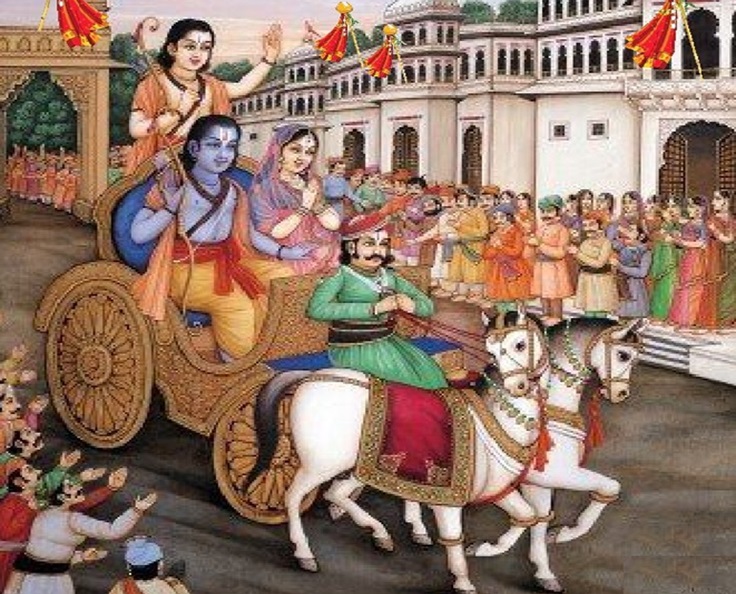
The Ayodhya Ram Mandir stands as a monumental symbol of India’s ability to navigate complex historical, religious, and socio-political challenges. The journey from the Babri Masjid-Ram Janmabhoomi dispute to the construction of the temple reflects the resilience of India’s democratic institutions and the commitment to finding a peaceful resolution to deeply divisive issues.
Ramayana And Temple Architecture
Ayodhya Ram Mandir Design Attempts To Present Complete Ramayana Story
The Ayodhya Ram Mandir, dedicated to Lord Rama, has a distinctive architecture that draws inspiration from the grandeur of Hindu temple design. The temple’s structure is characterized by intricate carvings, ornate spires, and symbolic representations that resonate with the complete Ramayana Story.
The central sanctum, housing the deity of Lord Rama, is a focal point designed to evoke reverence. The temple architecture often incorporates elements reflecting the divine events from the Ramayana Story, such as depictions of Lord Rama, Sita, Lakshmana, and Hanuman. Scenes from key episodes, like the building of the Rama Setu (bridge) and Rama’s victorious return to Ayodhya, are intricately carved on the temple walls.
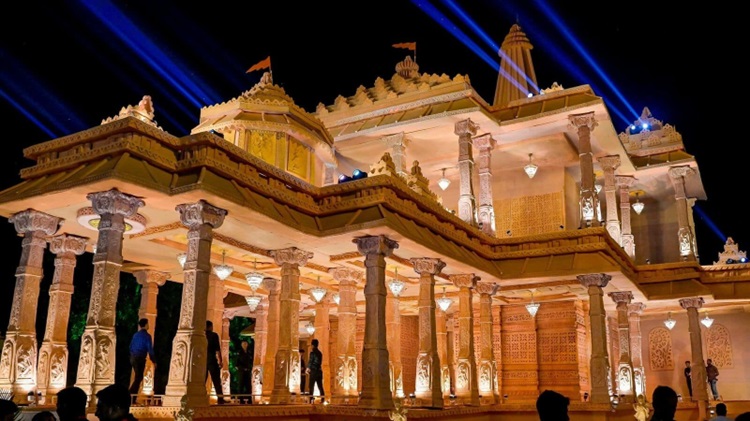
The temple’s design aligns with traditional North Indian temple architecture, emphasizing symmetry, multiple spires (shikharas), and detailed sculptures. Symbolic elements, such as lotus motifs and sculptures of divine beings, contribute to the spiritual ambiance.
The Ayodhya Ram temple stands as a cultural and architectural marvel, blending religious symbolism with artistic craftsmanship. It serves as a sacred space where devotees can connect with the divine energy of Lord Rama and immerse themselves in the timeless narrative of the Ramayana.
The Babri Masjid-Ram Janmabhoomi Dispute
The historical and religious significance of Ayodhya took a contentious turn with the Babri Masjid-Ram Janmabhoomi dispute. The controversy traces its roots back to the 16th century when the Mughal Emperor Babur commissioned the construction of the Babri Masjid in Ayodhya. The mosque, named after Babur, was built on a site believed by Hindus to be the birthplace of Lord Ram.
Over the centuries, the dispute simmered as religious sentiments clashed with historical claims. The situation intensified in 1949 when idols of Lord Ram appeared inside the mosque, leading to the locking of its gates. In 1986, the district court ordered the gates to be unlocked, allowing Hindus to worship inside the disputed structure.
Legal Battles And Court Verdicts
The Babri Masjid-Ram Janmabhoomi dispute found its way into the Indian judicial system, where it underwent a series of legal battles that spanned several decades. The case saw multiple hearings, with various courts providing different verdicts, adding complexity to an already sensitive issue.
In 2010, the Allahabad High Court delivered a landmark verdict, dividing the disputed land into three parts—one-third for the Sunni Waqf Board, one-third for the Nirmohi Akhara, and one-third for the deity Ram Lalla. The decision, while attempting to balance the interests of different parties, did not bring a conclusive end to the dispute.
The Ayodhya Verdict of 2019
The resolution of the Ayodhya dispute reached a pivotal moment on November 9, 2019, when the Supreme Court of India pronounced its judgment (Ayodhya Dispute Verdict 2019). The court unanimously ruled in favor of the construction of a Ram temple at the disputed site while allocating an alternate five-acre plot to the Sunni Waqf Board for the construction of a mosque.
The Supreme Court’s verdict was lauded for its attempt to find a fair and equitable solution to a deeply contentious issue. The decision acknowledged the historical and religious significance of the disputed site, emphasizing the need for communal harmony and reconciliation.
The Construction Of The Ayodhya Ram Mandir
With the legal hurdles cleared, the construction of the Ayodhya Ram Mandir commenced in full swing. The temple, designed to be an architectural marvel, draws inspiration from the grandeur of ancient Indian temple architecture. The complex is set to include not only the main temple dedicated to Lord Ram but also various other structures, including a museum showcasing the history of Ayodhya and the Ramayana.
The temple’s construction has been a collaborative effort involving contributions from people across India and beyond. The process has not only rekindled religious fervor but also fostered a sense of unity and purpose among the devotees who see the temple as a symbol of national pride and cultural heritage.
Symbolism And Cultural Significance
The Ayodhya Ram Mandir holds immense cultural and religious significance for millions of people. It represents the culmination of a long-standing dream for many Hindus who believe in the divinity of the birthplace of Lord Rama. The temple is not just a physical structure but a symbol of faith, resilience, and the preservation of cultural heritage.
The construction of the Ram Mandir also signifies the need for unity and understanding among diverse communities. The Supreme Court’s verdict and subsequent efforts to build both the temple and a mosque on separate sites demonstrate a commitment to inclusivity and communal harmony.
Ayodhya Ram Temple Architecture
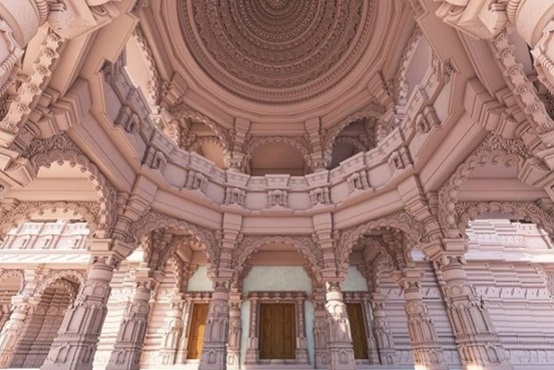
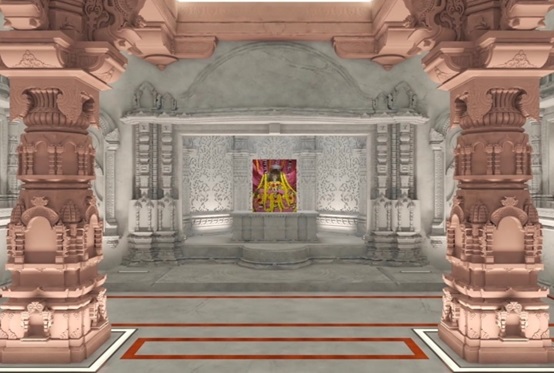
- Traditional Indian Architecture:
The design of the Ram Mandir is expected to adhere to traditional Indian architectural styles, reflecting the grandeur and aesthetics of ancient Indian temples.
- Nagara Style:
The temple is likely to follow the Nagara style of temple architecture, which is prevalent in North India. This style typically features a curvilinear spire, intricate carvings, and a sanctum at the center.
- Shikhar (Spire):
The temple’s shikhar (spire) is expected to be a prominent architectural feature. Traditional Nagara-style shikhars are often tall and have multiple tiers, adorned with sculptures and decorative elements.
- Mandapa (Pillared Hall):
Temples in the Nagara tradition often have a mandapa, a pillared hall, used for gatherings, rituals, and ceremonies. The mandapa is characterized by intricately carved pillars.
- Garbhagriha (Sanctum Sanctorum):
The sanctum sanctorum, or garbhagriha, is the innermost chamber where the main deity’s idol or deity’s representation is enshrined. It is the most sacred part of the temple.
- Stone Carvings:
Stone carvings depicting scenes from the Ramayana, other Hindu epics, and intricate motifs are likely to adorn the temple’s walls and pillars.
- Artisans and Craftsmanship:
Skilled artisans and craftsmen from various parts of India are expected to contribute to the construction. The project emphasizes traditional craftsmanship and skills passed down through generations.
- Landscaping and Surroundings:
The overall architectural plan may include well-designed landscaping and surroundings to enhance the aesthetic appeal of the temple complex.
- Tourist and Pilgrim Facilities:
Considering the expected influx of tourists and pilgrims, the architectural plan may include facilities such as visitor centers, accommodation, and amenities for the convenience of those visiting the temple.
How to Reach Ayodhya ?
How to Reach Ayodhya Ram Mandir ?
Ayodhya By Air
Lucknow International Airport is the nearest Airport which is 152 Kms from Ayodhya. Ayodhya is about 158 Kms from Gorakhpur Airport, 172 Kms from Prayagraj Airport and 224 Kms from Varanasi Airport.
New Ayodhya Airport
PM Narendra Modi Inaugurates New Ayodhya Airport
Prime Minister Narendra Modi inaugurated the Maharishi Valmiki Airport in Ayodhya on Saturday 30th December 2023.
Maharshi Valmiki, a revered sage in Hindu tradition, is credited with composing the epic Ramayana. Written in Sanskrit, the Ramayana narrates the life of Lord Rama, an incarnation of the god Vishnu, his wife Sita, and his loyal devotee Hanuman.
The new airport in Ayodhya will provide a major impetus to develop the Ayodhya city as major tourist destination. The Ayodhya airport will be connected to both domestic and international flights.
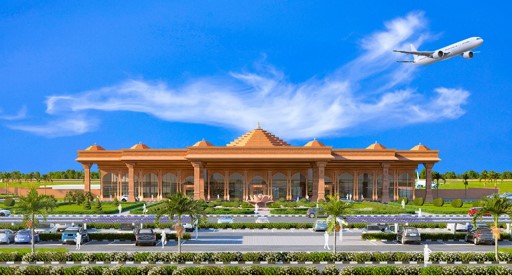
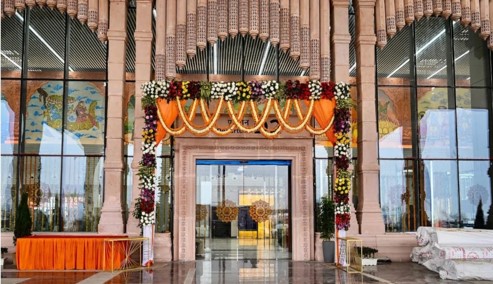
Ayodhya Ram Mandir
Maharishi Valmiki Airport , Ayodhya Location
Ayodhya By Railway
Faizabad and Ayodhya are major railway stations of the district and are well connected to almost all major cities and towns. By Rail route Faizabad is 128 kms. from Lucknow, 171 kms. from Gorakhpur, 157 kms. from Allahabad and 196 kms from Varanasi. By Rail route Ayodhya is 135 kms. from Lucknow, 164 kms. from Gorakhpur, 164 kms. from Allahabad and 189 kms from Varanasi.
New Ayodhya Dham Railway Station
PM Narendra Modi Inaugurates New Ayodhya Dham Railway Station
Indian Prime Minister Narendra Modi has inaugurated the newly redeveloped to international standards, Ayodhya railway station on December 30, 2023.
The newly constructed Ayodhya railway junction was also given a new name: Ayodhya Dham junction. PM Modi also flagged of number of high speed modern “Vande Bharat” trains to improve rail connectivity of Ayodhya.
The new Ayodhya Dham railway station building has been given a temple architecture facade as a tribute to Lord Ram, while the interior boasts “airport-like” amenities.
The inauguration of the new station building assumes significance ahead of the consecration ceremony at the Ram Mandir on January 22, 2024, after which Ayodhya is expected to see a rush of pilgrims and tourists.
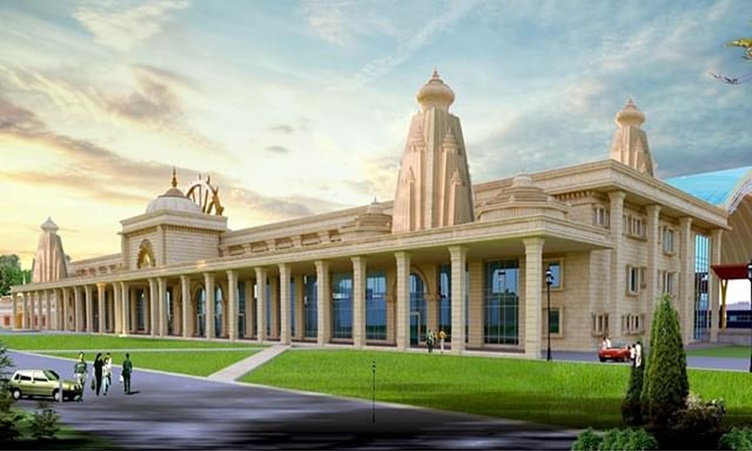
Ayodhya Dham Railway Station Location
Ayodhya By Road
Services of Uttar Pradesh Transport Corporation buses are available 24 hours a day, and it is very easy to reach here from all places. By Road Faizabad is 152 kms from Lucknow, 158 kms from Gorakhpur, 172 kms from Allahabad and 224 kms from Varanasi. By Road Ayodhya is 172 kms from Lucknow, 138 kms from Gorakhpur, 192 kms from Allahabad and 244 kms from Varanasi.
Pran Pratishtha Puja
Ayodhya Ram Mandir Consecration Ceremony
Scheduled For January 22, 2024 at 12.20 PM
The Ram Mandir “Pran Pratishtha” pooja ceremony scheduled for January 22, 2024, is being organised and managed by Shri Ram Janmbhoomi Teerth Kshetra Sanstha. The mega Vishwa Hindu Parishad vice president, Jagadeesh Hebbar, announced preparations for the upcoming consecration ceremony of Sri Ram Mandir in Ayodhya on January 22.
Prime Minister Narendra Modi will be the chief guide for this mega event. The event will also be attended by other top leaders from the ruling BJP, the RSS, members of parliament, and other top dignitaries.
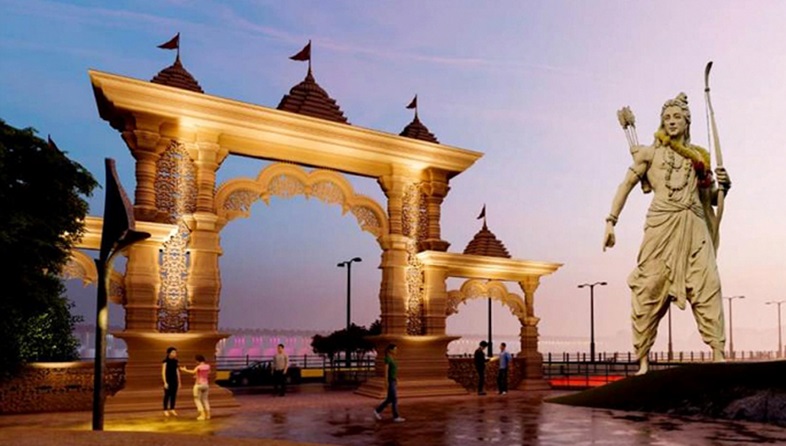
PM Modi has personally appealed to Hindus and followers of Sanatana Dharma to celebrate the day like a Diwali festival and light Ram Jyoti in every house across India. Big LED screens will be set up in multiple locations in Ayodhya City for people to watch the ceremony.
On December 30, 2023, PM Narendra Modi already inaugurated a swanky new Ayodhya Dham railway station and a state-of-the-art Maharshi Valmiki International airport. Ayodhya is gearing up on war footing for this historical event.
All major city streets will be bedecked with flowers, and the entire city will be illuminated with decorative lights. Ayodhya has undergone a stunning makeover just three weeks ahead of the Ram Mandir consecration ceremony.
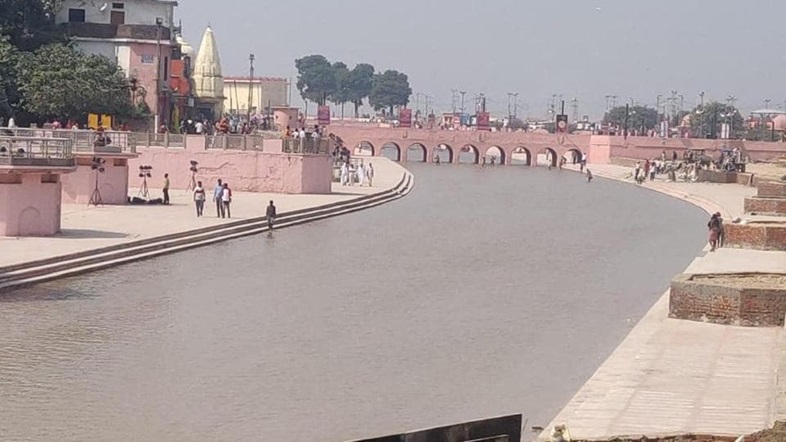
Amrit Mahotsav
Along with the inauguration of the grand construction of Ramlala in Ayodhya in January 2024, the Amrit Mahotsav of the birth of Padmashri Jagatguru Rambhadracharya will also be organized. The Amrit Mahotsav will be organised by disciples of Jagatguru Rambhadracharya in Ayodhya from January 14 to 22. Prime Minister Narendra Modi will also attend the nine-day Amrit Mahotsav celebrations.
Ayodhya Ram Mandir
राम मंदिर प्राण प्रतिष्ठा पूजा का स्टेटस
The ‘Pran Pratistha’ ceremony, the religious rituals from the Ram Temple in the holy city Ayodhya began on Tuesday, 16th Jan 2024. The seven-day ceremony will reach its finale with the consecration of the idol of Lord Ram at the new temple in Ayodhya.
Ram temple chief priest Satyendra Das shared that the ‘Anushthan‘ has started and will continue till January 22, the day of the consecration ceremony. He also informed that a group of eleven priests are performing the rituals invoking the blessings of all goddesses and gods.
Ram temple chief priest Satyendra Das also confirmed that Prime Minister Narendra Modi will deliver an inaugural speech at the end of the consecration ceremony in the presence of over eight thousand special invitees and guests.
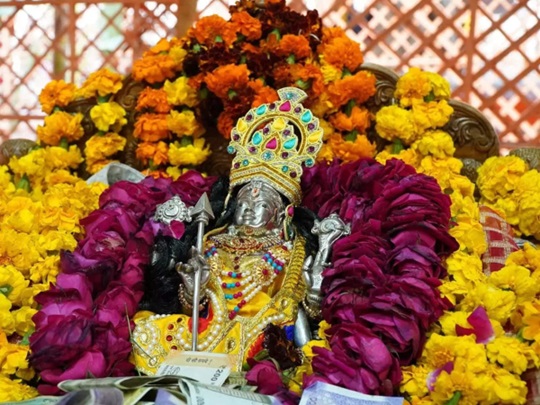
However, during the consecration ceremony, PM Modi will be accompanied by only selected group of people inside the sanctum sanctorum of the temple. Some rituals including the ‘prayaschita’ and ‘karmakuti poojan’ have already taken place. Subsequently, remaining rituals will also be followed which include rituals like ‘teerth poojan’, ‘jal yatra’ and ‘gandhadhivas’ .
Temple trust general secretary Champat Rai said the ‘pran pratishtha’ will begin at 12.20 pm on January 22 and is expected to end by 1 pm.
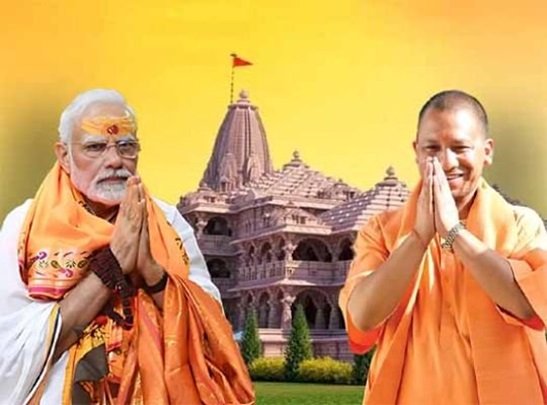
The BJP government, led by Prime Minister Narendra Modi And UP Chief Minister Shri Yogi Adityanath , is fully committed to fulfilling their most important promise to the nation to construct Ram Temple in Ayodhya.
During his inaugural address, PM Modi appealed to the entire nation to prepare for the historic moment of the Ram Mandir “Pran Pratishtha” pooja ceremony scheduled for January 22, 2024 at 12.20PM.
Ram Temple Project Current Status
Transcript of the Press Release By The Trust on Current Status.
As On January 18, 2024
Ahead of the consecration ceremony of the Ram Temple in Ayodhya on January 22, the Sri Ram Janmabhoomi Tirath Kshetra Trust released photos showing the current status of Shri Ram Janmabhoomi Mandir construction work.
The replicas and the 3D Mandir models offer a visual representation of the sacred structure, giving devotees a sense and feel of the grandeur of the ‘Pran Pratishtha’ ceremony as it unfolds on the scheduled dates.
The construction of the temple has been progressing as per schedule and at a steady pace under the supervision of the Sri Ram Janmabhoomi Tirath Kshetra Trust.
The idol of Ram Lalla will be in the sanctum sanctorum of the temple. The Shri Ram Janambhoomi Trust had also shared pictures of the floor Inlay work under process in Shri Ram Janmabhoomi Mandir and intricate arvings inside the temple.
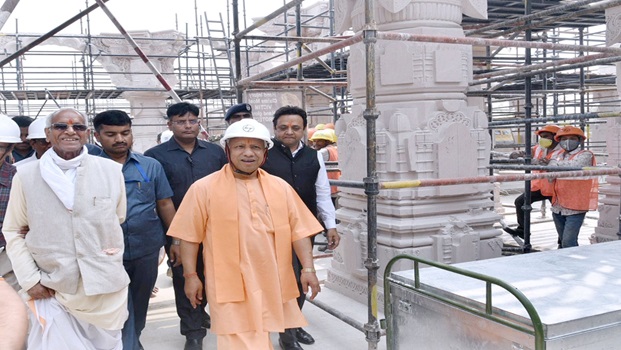
Earlier, the General Secretary of Shri Ram Janambhoomi Trust, Champat Rai, said that the idol depicting the child form of Lord Ram is 90 percent ready.
“At Ram Janambhoomi temple, a 4’3” idol depicting the 5-year-old child form of Lord Ram is being constructed at three locations in Ayodhya. Three artisans are building the idol on three different pieces of stone, and one of the idols will be accepted by the Lord. These idols are 90 percent ready, and the finishing work will take about a week to be done,’ said Champat Rai.
“The idol will be installed in the ‘Grabhgriha’ on the ground floor. The ground floor of the temple is almost ready. So, there will be no problem with ‘Praan-Pratishtha’ (Consecration ceremony),” he added. He further mentioned that at least 4000 sadhus are being invited to the ‘Praan-Pratishtha’ ceremony. The list of further invitees is also ready.
Prime Minister Narendra Modi will attend the inauguration of the Ram Temple in Ayodhya on January 22 next year.
Vedic rituals for the Pran-Pratishtha (consecration) ceremony of Ram Lalla (infant Lord Ram) in Ayodhya will begin on January 16, next year, a week before the main ceremony.

